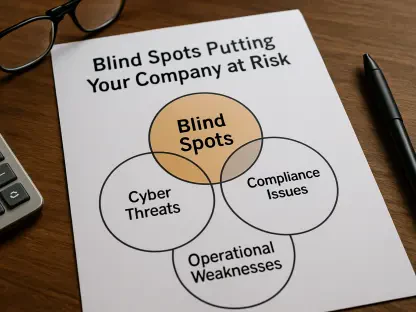Imagine a sprawling digital landscape where countless devices, workloads, and applications connect through the vast expanse of cloud infrastructure, forming a complex web of interactions that define the modern organizational ecosystem. This is the reality for most organizations today, where the boundary between internal systems and external endpoints—known as the cloud edge—has become a prime target for cyber attackers. With data breaches costing companies millions annually and the proliferation of Internet of Things (IoT) devices expanding this attack surface, securing the cloud edge is no longer optional but a pressing necessity. This review dives deep into the technology behind cloud edge security, exploring its vulnerabilities, emerging solutions, and real-world implications in an era of distributed IT environments.
Understanding the Cloud Edge as a Vulnerable Frontier
The cloud edge represents the critical interface between an organization’s cloud infrastructure and external endpoints such as devices, applications, and workloads. Unlike the traditional network edge, which often remains under direct organizational control, the cloud edge frequently relies on public infrastructure, posing unique challenges in terms of visibility and management. This distinction means that data and communications often traverse unsecured pathways, heightening the risk of interception by malicious entities.
As cloud computing continues to dominate enterprise strategies, the significance of the cloud edge in cybersecurity cannot be overstated. The expansion of remote workforces and the integration of diverse endpoints have amplified the attack surface, making it a focal point for threats. This evolving landscape demands a reevaluation of conventional security measures to address the specific risks associated with this dynamic boundary.
Core Vulnerabilities at the Cloud Edge
Limited Visibility into Connected Assets
One of the most pressing issues in cloud edge security is the lack of comprehensive insight into the myriad assets interacting with cloud environments. Many organizations struggle to track IoT devices, developer-initiated workloads, service accounts, and even artificial intelligence (AI) agents that connect to their systems. This gap in awareness creates dangerous blind spots that attackers can exploit with ease.
Without proper monitoring, these untracked assets become potential entry points for cyber threats. The inability to identify and secure every connected element means that vulnerabilities often remain undetected until a breach occurs. Addressing this challenge requires robust tools and processes to map and manage the full scope of cloud-connected entities.
Risks in Data Transmission
Another significant concern lies in the insecurity of data as it moves across the public Internet between edge devices and cloud systems. Such transmissions are inherently exposed to interception, making them a prime target for exploitation by adversaries seeking sensitive information. The absence of stringent safeguards exacerbates this risk.
To mitigate these dangers, robust encryption and secure connection protocols are essential. Ensuring that data remains protected from edge to cloud is a fundamental requirement, yet many organizations still fall short in implementing these measures consistently. This vulnerability underscores the need for a proactive approach to securing communications in distributed environments.
Evolving Strategies and Technological Trends
The shift away from traditional perimeter-based security models toward more adaptive frameworks marks a significant trend in addressing cloud edge challenges. Concepts like zero-trust architecture, Secure Access Service Edge (SASE), and software-defined wide area networks (SD-WAN) have gained traction as effective ways to manage the distributed nature of modern IT setups. These approaches prioritize verification and access control over assumed trust.
Network-layer solutions such as microsegmentation and end-to-end encryption are increasingly relied upon to compensate for limitations at the endpoint level. Microsegmentation, in particular, isolates workloads and devices into smaller, manageable segments, reducing the potential impact of a breach. This granular control is vital for minimizing risks in expansive cloud environments.
Expert consensus highlights the urgency of rethinking security paradigms to keep pace with evolving threats. The distributed workforce and reliance on cloud infrastructure necessitate a departure from outdated models, pushing for integrated strategies that combine identity, endpoint, and network protection. This holistic perspective is shaping the future of cybersecurity at the cloud edge.
Real-World Applications and Cutting-Edge Innovations
Across various industries, cloud edge security solutions are being deployed to safeguard critical operations. In sectors like technology and manufacturing, companies are leveraging these technologies to protect complex IoT ecosystems, ensuring that connected machinery and sensors remain secure from external threats. These implementations showcase the practical value of advanced security measures.
Innovative approaches, such as obfuscation technologies and deflection clouds, are also gaining attention for their dual benefits of enhanced security and performance. By dynamically adapting to traffic patterns—often influenced by AI workloads—these solutions obscure network paths, making unauthorized access nearly impossible. Such advancements represent a significant leap forward in protecting distributed systems.
Unique use cases further illustrate the versatility of cloud edge security. For instance, securing AI-driven workloads in cloud environments requires tailored strategies to handle unpredictable data flows. Similarly, remote workforces depend on secure access solutions to maintain productivity without compromising safety, highlighting the adaptability of modern security frameworks to diverse needs.
Challenges and Constraints in Securing the Edge
A notable obstacle in cloud edge security is the technical limitation of low-powered edge devices, which often lack the computational capacity to support endpoint protection or robust encryption. This inherent weakness means that many IoT devices and similar endpoints remain vulnerable, unable to run sophisticated security agents effectively.
Emerging technologies like AI and quantum computing introduce additional threats, potentially accelerating the discovery of vulnerabilities and challenging existing encryption standards. The rapid evolution of these fields could outpace current security measures, necessitating forward-thinking strategies to anticipate and counteract future risks.
Efforts to overcome these hurdles are underway, with a focus on cloud-native security architectures that prioritize scalability and adaptability. Proactive measures, including enhanced network controls and policy enforcement, aim to bridge the gap between resource-constrained devices and comprehensive protection, ensuring a more resilient defense posture.
Future Prospects for Cloud Edge Protection
Looking ahead, the trajectory of cloud edge security points toward deeper integration of zero-trust frameworks with identity and endpoint protection mechanisms. This convergence aims to create a seamless security fabric that addresses both current vulnerabilities and anticipated challenges, fostering a more robust defense against sophisticated threats.
The long-term impact of AI and quantum computing on security strategies remains a critical area of focus. As these technologies advance, they will likely necessitate adaptive approaches that can evolve alongside emerging risks. Preparing for such disruptions requires investment in research and development to stay ahead of potential exploits.
Innovations in network obfuscation and granular policy enforcement hold promise for redefining security at the cloud edge. By rendering unauthorized access infeasible and ensuring strict access controls, these advancements could set new standards for protecting distributed environments, paving the way for a more secure digital future.
Final Reflections and Next Steps
Reflecting on this comprehensive evaluation, the exploration of cloud edge security revealed critical insights into its vulnerabilities and the innovative strategies deployed to counter them. The analysis underscored the pressing need for visibility, robust encryption, and network-layer solutions like microsegmentation to tackle the unique challenges of this attack surface.
Moving forward, organizations need to prioritize the adoption of zero-trust principles and invest in technologies that enhance asset awareness and secure data transmission. Collaborating with industry leaders to develop adaptive frameworks that anticipate threats from AI and quantum computing is essential for long-term resilience.
As an actionable step, integrating cloud-native security architectures offers a path to balance performance with protection, ensuring that even resource-constrained devices can be safeguarded. This strategic focus promises to strengthen defenses and prepare enterprises for the evolving complexities of distributed IT landscapes.









